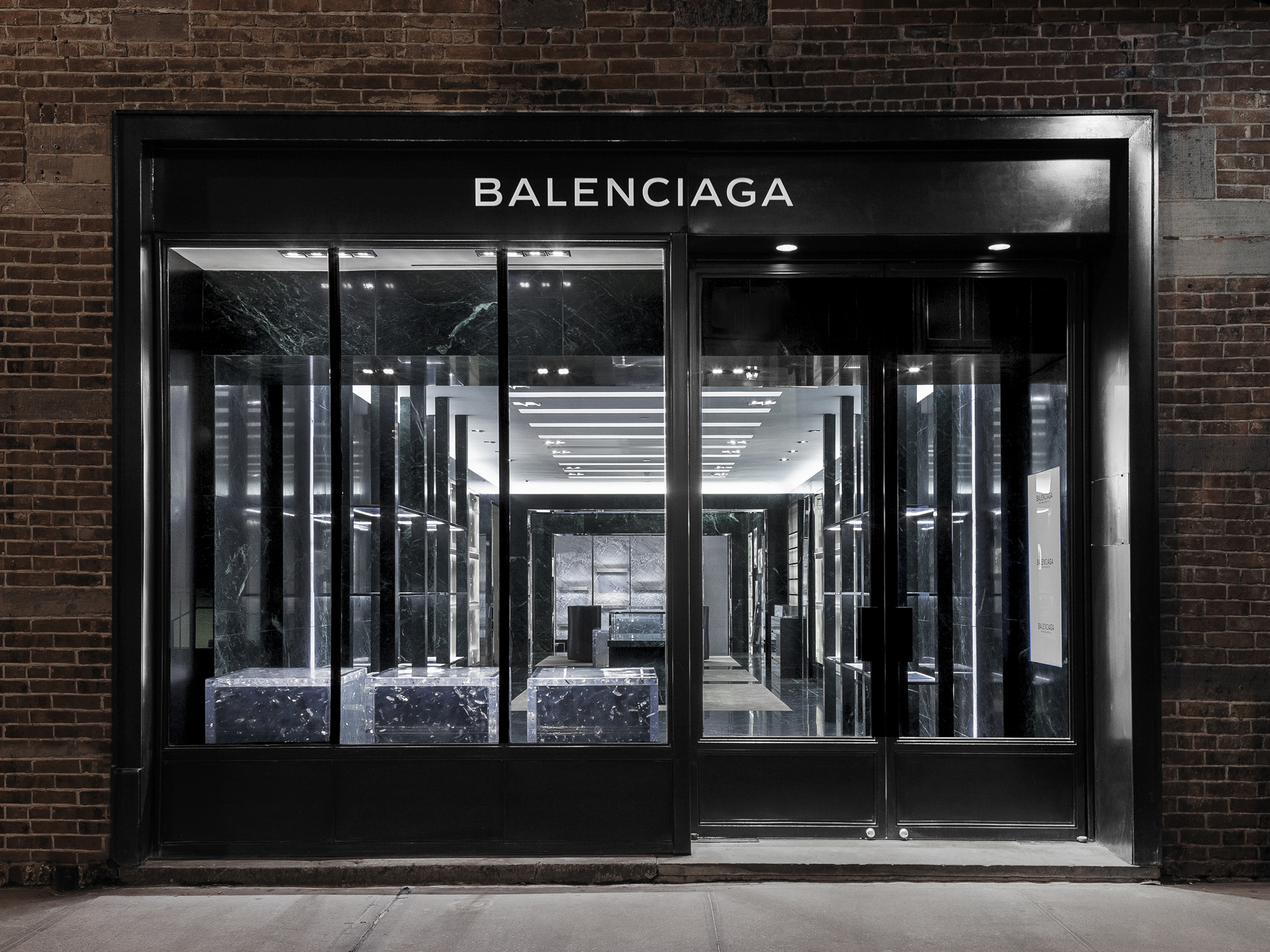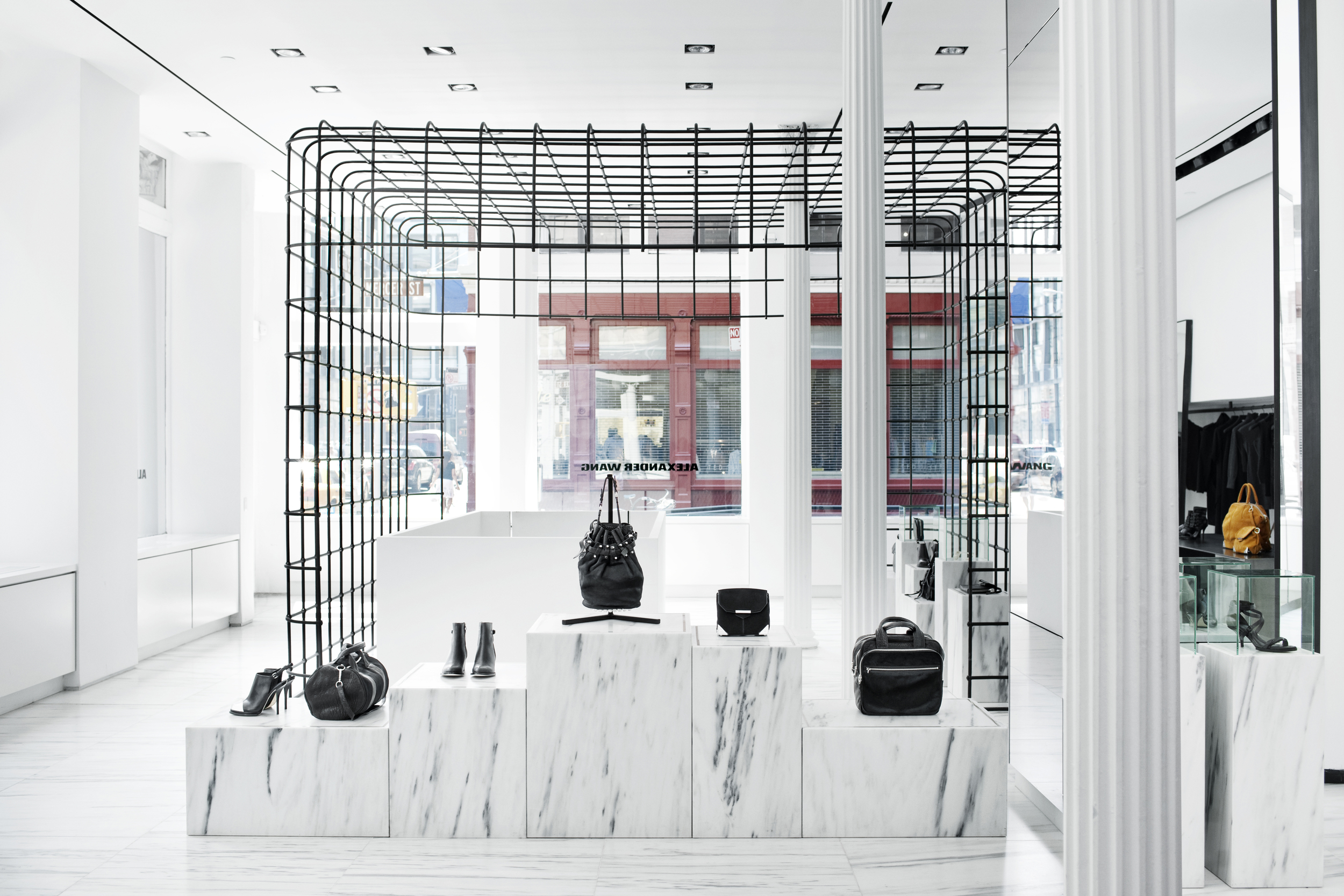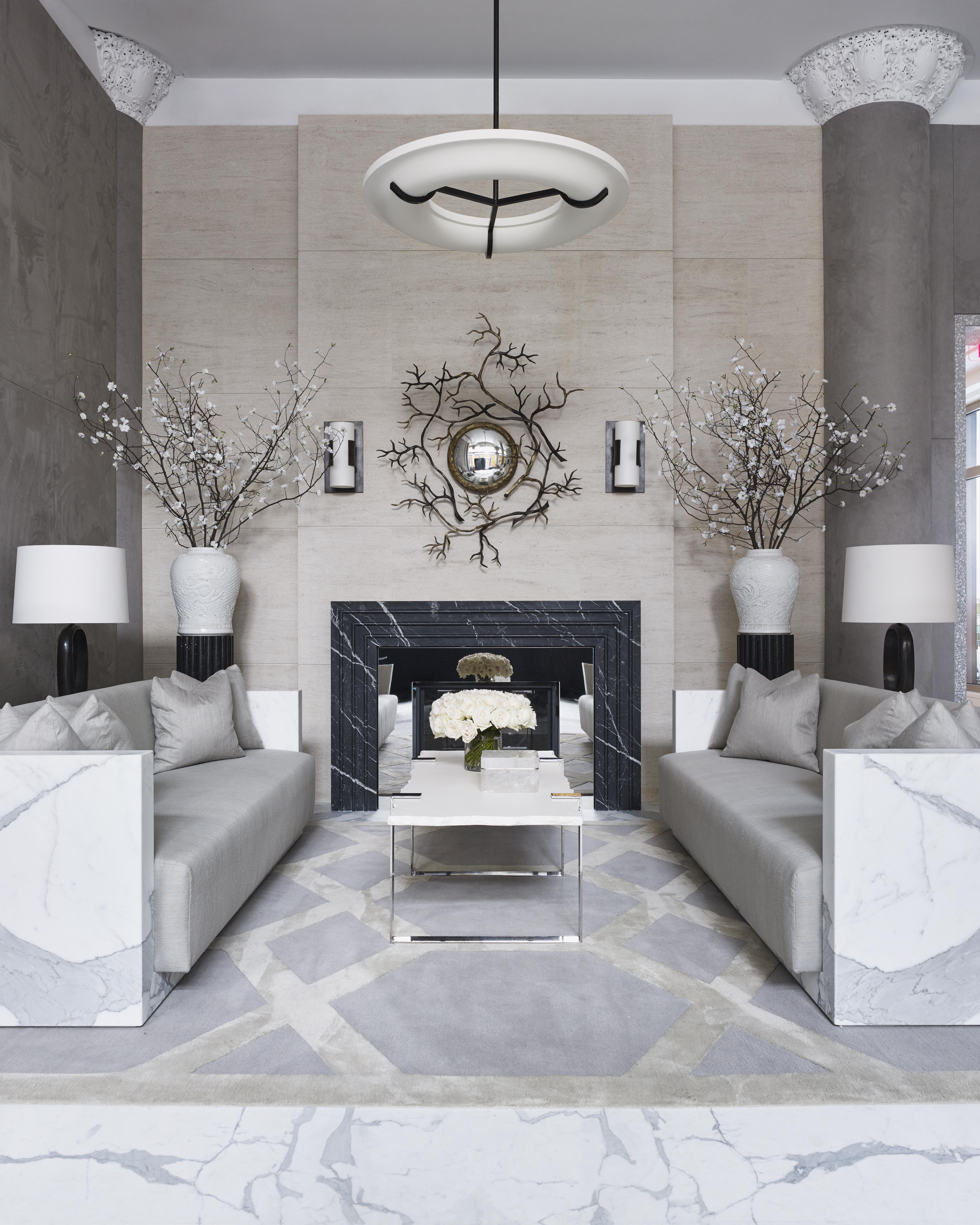The aesthetic of interior designer Ryan Korban—whose work spans some of the finest retail spaces in New York including the flagships for Alexander Wang, Balenciaga, and Altuzarra—is sexy, bold and clean. Just don’t call it glamorous. “I cringe when people call my style ‘glamorous.’ That’s sort of haunted me my whole career,” he says over the phone. “I mean, I get why people say it but for the last few years I’ve really tried to find a better word. I suppose the best way I’d describe my work is fresh. No matter what material I’m using, whether it’s traditional or modern, I think you do feel that freshness.”
Korban has consistently strived to illustrate this sense of innovation through his modern take on traditional design and interiors, something he calls “luxury redefined,” that aptly became the title for his 2014 coffee table book.
Reinvention is key to his work, a thesis he hopes to emphasize at the upcoming Collective Design fair, which takes place March 9 to 11th in New York as part of Armory Arts Week. One off custom furnishings will inhabit the space, such as statuary marble sofas, mixed terrazzo flooring, suede-paneled walls and a heavy limestone coffee table—all custom designed by Korban. The most unexpected addition to his distinctive portfolio, however, is the new luxury condominium at 40 Bleecker Street that will mark his first full condo building. “It’s the first time a luxury condominium is branded as Ryan Korban. It’s the first time you can buy a Ryan Korban penthouse!” he says excitedly.
As the New School alumnus continues to transform the landscape of modern interiors, he talks about how he has left an indelible mark on the luxury fashion experience.
JEENA SHARMA: Tell me about your work with Balenciaga.
RYAN KORBAN: My first project with the brand was the store on Mercer Street. Simultaneously, they asked me to help create new concept for the men’s ready-to-wear store across the street. So we started working on both of those spaces. That was also the first time that the Balenciaga retail experience had a new look in North America. What inspires me is quite traditional but my work is really modern. But with Balenciaga, it was really more about looking into the past than create something that’s super modern and contemporary.
SHARMA: How do you translate a brand’s vision into a concept for a retail space?
KORBAN: This is one of my favorite working relationships. I love working with designers! I love being able to take a designer’s world and figure out how I can create an environment for it. For most people, the designer is the client. But I’ve found more satisfaction and success in seeing the product as the client. So if you’re a ready-to-wear company, it’s the collection that matters and if you’re an accessories company, it’s the footwear. I’ve always taken that approach when working with a designer. Fashion designers have such a distinct point of view, you can get lost in that.
If you focus on the product or the collection and if you’re able to extract from that, that really works. The other approach is to look at the designer’s work and what the common spread is, which allows you to build an environment that feels true to what that brand is and not necessarily focus on what they’re doing next season. What I really do is try and the pick the DNA of the brand or the designer and translate it into an environmental language. That’s how I start that process.
A lot of designers are really fantastic at what they do in terms of creating clothing or accessories—they know what they like in terms of environment. But sometimes they don’t know exactly how to get it to that level. So it’s really rewarding to be able to do that for them and to create a space that is a complete expression of the brand’s message and what they’re trying to sell.

MEN’S BALENCIAGA FLAGSHIP, IMAGE COURTESY OF RYAN KORBAN
SHARMA: Do you pick a certain element of a collection and then decide to incorporate it into a concept or is it the collective brand identity that’s more important to designing a store?
KORBAN: I think you start building a language and that language starts becoming the brand identity. It really depends. For instance, when I was working with Alexander Wang, sometimes he would get inspired by the materials that we were using to build the spaces and they’d work their way into the collection. The other times, I would get inspired by what he was doing in particular with that project.
In his inaugural collection for Balenciaga, you’ll notice a recurring green marble symbol throughout the lineup something that’s also part of the flagship store. That’s because he didn’t want things to be black. Black and white was the DNA and colors to his own brand. He wanted to create something that felt like him in terms of a darkness but we also really wanted to make sure it had heritage. I remember being in Europe and seeing this green stone across these buildings and in old architecture. There was something about it that felt very outdated but inherently European. So we took that and mixed it with fudge limestone. It then turned into 30 feet of walls with green stones and modern lights and other modern things. That’s where that started and where the stonework originated from. It was about getting inspired by something European and then modernizing it. We also felt that that was something that could be part of a collection but still feel relatively neutral as a backdrop.
So I think when you’re working with a designer, it’s really about playing off each other. When you take instances like these, you can really see that the collection is really the client. That’s really how a collection inspires an environment.

ALEXANDER WANG FLAGSHIP IN NEW YORK, IMAGE COURTESY OF RYAN KORBAN
SHARMA: Have you ever worked on a project where you had full creative control and could really imprint your own style and vision into it?
KORBAN: Yeah, and those are amazing projects where you really get to decide what the DNA of a brand is going to be, especially when you’re working with a brand that’s just opening up or has never existed before. That happens a lot more with multibrand stores. Some of those stores that I have done are my favorites. But essentially, I look at every project as creating an environment for a brand. Sometimes those brands have a strong DNA and sometimes they’re brand new.
SHARMA: How do you strike a balance between making sure a store feels luxury but also inviting and not intimidating?
KORBAN: That’s always a balance I’m trying to strike. I’ve made mistakes in the past where a space felt too intimidating. What I strive to do most with my work is create something that feels fresh, modern, and a younger take on something traditional.
It’s funny you ask that question because it’s still a challenge for me. And right now with my work for Collective Design, I’ve been asking that question a lot. What I’m doing there is an ultimate study of that. I talk about it a lot with my team because I am not afraid to say I’m wrong. I believe when you create something, it should make you stop for a minute and sort of say, “Wow.” I want my kind of wow movement but I try and balance it in a way that feels new and not stuffy. Especially when I was doing Alexander Wang’s store on Mercer Street, which was seven years ago. That idea of creating something that’s not intimidating but also exciting kind of manifested itself in the fur hammock that’s in that store. The way it’s done with the cashmere, when you see it, you go like, “Wow,” but it’s also done in a tasteful way. I also created these sofas for the Collective Design fair that are made completely out of statuary marble. That’s another thing that strikes that balance, which is a little intimidating but also has that wow factor.
SHARMA: What’s been harder creatively: designing a personal space or retail?
KORBAN: I think one is really personal and the other one is more of a strategic job. They’re both challenging in a different way. Working with an individual is obviously more personal, which is challenging at times, but also very rewarding. It’s just much more of an emotional process.
SHARMA: You use a lot of animal skins and prints in your work as well as marble. Is there a specific reason?
KORBAN: I don’t really gravitate towards patterns and colors. When I started I really just had a neutral color palette. I think animal textures and palette just started to become part of my prowess, over the years. I started experimenting with animal patterns and that just sort of developed further.
As for marble, stones are my favorite. They always have been. When I sit down on a new project, I’m always thinking how do we make this more permanent, and how do we make it feel like it’s been here. I like making something monumental. Stones have always been the material that really grounds things. It’s just that power, you know. I love knowing that something’s not going anywhere.

EDON MANOR, IMAGE COURTESY OF RYAN KORBAN
SHARMA: Are there certain designers you’d like to work with in the future?
KORBAN: There’s no one specific, to be honest. I’m open to everything. I know that’s not an exciting answer but I accept any challenge that comes my way. My philosophy has never been, “Oh, I’m dying to work with this person.” It’s sort of about, “What’s next?” That’s what I’m excited about.
SHARMA: What are the three essential accessories you’d recommend for a home or a personal space?
KORBAN: Lighting, lamp, mirrors, and interesting seatings.
SHARMA: What is the tackiest home accessory?
KORBAN: The tackiest? [laughs] Oh, I don’t know. That’s a hard question to answer. I think it’s best to never say never. I mean, I love wall-to-wall carpet, for instance. Some people think it’s the tackiest thing in the world, but for me, it’s luxury. There have been times where I’m like, “I hate that,” and then years later, it’s almost like I’m drawn to it.
I think there are two types of designers; there are those that have a very clear artistic vision and that’s what they go with. Then there are designers like me. I think it comes from my background of working with brands, where you let the projects dictate your taste. I’m very much that kind of person. I feel like I’m constantly exploring with different looks and things. So, I don’t think any two of my projects would look alike.
SHARMA: What’s next for you?
KORBAN: I’m doing everything I want to do. So my biggest goal right now is to just keep doing it. I just did interiors for a high-end condo building. It’s the first time a luxury condominium is branded as Ryan Korban. It’s the first time you can buy a Ryan Korban penthouse! I’m launching a book and a furniture line, and I’m doing the Collective Design fair. People ask me about my dream project and client all the time. But what’s next is I just want to keep it going. I’ve been very fortunate and I love the projects that I did and I’d like keep doing them. I’m open to anything and I’m always excited about new sectors that are growing.
COLLECTIVE DESIGN WILL HOST ITS SIXTH FAIR MARCH 9-11, 2018 AT SKYLIGHT CLARKSON NORTH.
The article was published first in interviewmagzine.com.
